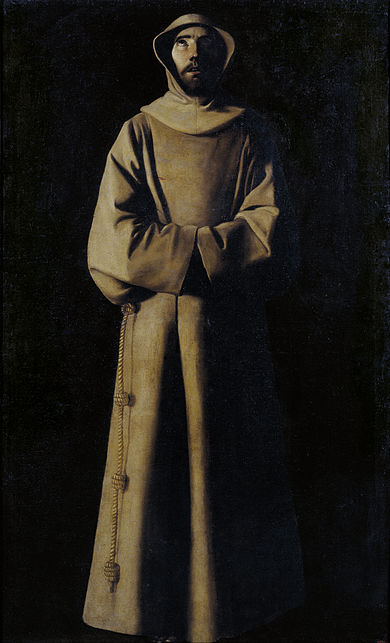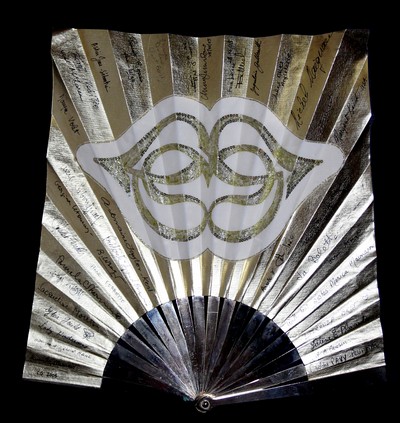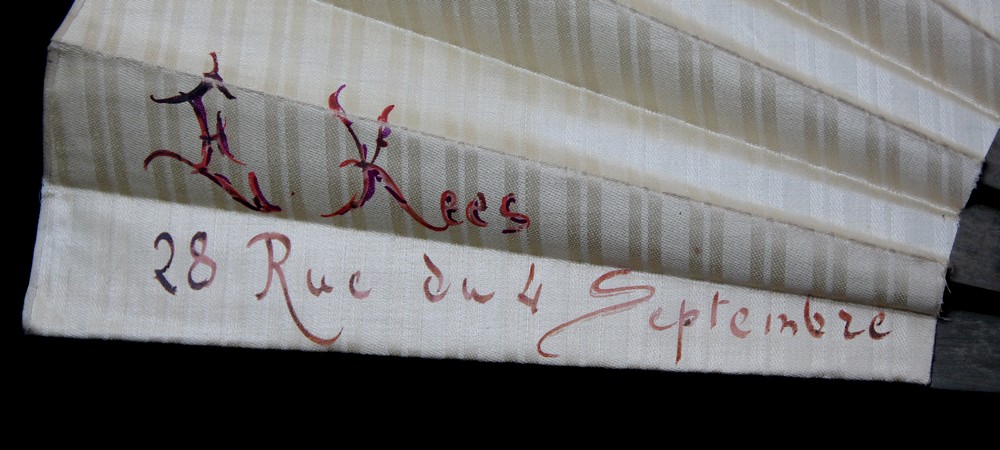|
|
|
|
Ici, cette page en français !
The French Nineteenth century and early Twentieth were less afraid of caricature than is our early Twenty-First century. Many polemicists or designers of the time would have been nowadays fined or imprisoned, for the irreverent texts or designs they produced then. Particularly, anticlericalism took then a magnitude that previous epochs in this century had not tolerated. This left traces in one of the French conceptions of secularism, which is not always seen as respect for religion and conscience but rather as a battle against the Roman Catholic Church.
Are the fans we present below in this vein? We do not know, and that's why we ask our readers.
A diabolical Capuchin?
This "plein vol" (180° span) fan has wooden (fruitwood?) sticks. They are tinted in bronze green and pierced with leaf motifs. The guards have similar motifs but sculpted in relief. The rivet is made of metal, with a brass loop. The double leaf is made of fabric (satin silk). The obverse is painted in gouache, the reverse is woven with tonal stripes.
The obverse is particularly original. Besides an architectural element on which is written: "Couvent des Capucins - Salle Pérot, 27 avril 1881", a Capuchin monk, a rosary around his neck, his head buried under his cap, holds in his right hand a crucifix. The left hand is in a move that seems designed to push (more than to bless) a swarm of ten fantastic creatures, appearing in a luminous cloud. On the left, closest to the monk is a quadruped with a long neck and, apparently, two oblong breasts pointed skyward. At the center, another being is like a dark spider with four legs. At the right is another bipedal long nosed and wide eyed monster, with a tail and a crest but without visible wings. Above is a crowd of seven flying creatures. A couple of them vaguely resemble birds, the others being completely fantastic.
We had never seen such a fan... but in 2023 we found another one ! Here it is:
Kathy Maxwell, an Australian fans collector and researcher, had reminded us of a fan by Clairin for the fanmaker Alexandre (which we think was auctioneed some years ago?). It was illustrated in 1883 by La Vie Parisienne. The object we show here was perhaps a source for the illustrious Clairin and Alexandre? This fan (or a similar one, because the designs are not identical) belongs to the Fan Museum in London, and can be seen here.
(photo B.n.F. www.gallica.fr)
As for the fans we are studying, the first one failed in a first auction sale to attract bidders, perhaps because of its strange character. Lucie Saboudjian, expert, whose hand fans experience is long and whose competence is widely recognized, had in fact titled this lot "Le Capucin diabolique" (the Diabolical Capuchin). She described: "a Capuchin invoking the succubus." That, in our view, was enough to decrease the number of bidders, most of them being respectable undevilish ladies! But, of course, this was a humorous notation meant to relax the sales room, as our own words only want to entertain our visitors.
But what indeed are the Succubuses? We did not meet them in or since 2016; at least do not we recognize them. The etymology is accessible to the beginner Latin scholar since the word is formed of sub (under) and cubare (to sleep, or to lay on). The Oxford dictionary online gives the following definition: "A female demon believed to have sexual intercourse with sleeping men". Note that in French sucubuses are male. The French Academy, in its 1718 dictionnary wrote:.. "Succubus, masculine substantive. They are called the devil, when, in the opinion of some people, they take the form of a woman to have carnal company of a man". The Academy linked the word with its antonym "Incubus", whose definition was " Sort of demon that, following a popular error, abuse of women." We leave our readers specialists of gender studies think about the differences between these two definitions. In our opinion, devils, being fallen angels, are asexual.
Anyways we do not see here, unfortunately, lovely young women but, probably, the demons before they take on this prettier appearance. But how ist it possible to confirm this statement? It is indisputable that the monk depicted on the fan wears a garment used by the monks of the Franciscan family (founded by Saint Francis of Assisi, dear to Pope Francis, who borrowed his name). The Capuchins are characterized by the use of the cap which, by its color and the fact that sometimes their bure includes a white part has given its name to the famous cappuccino. Without a doubt, as proved by the comparison with a Zurbaran's painting showing the saint, the monk depicted here is a Capuchin. We see besides him his floating girdle, whose nodes recall the vows of poverty, chastity and obedience. The second would be greatly compromised by the action of succubus...

Museu Nacional d'Art de Catalunya
Inventory number: 011528-000
Does the Capuchin on the fan invoke succubi (if they are succubi: remember that to fool the men they take more attractive forms!!!). We would think he rather repels them, before he succumbed to the charms of their avatars ... or after. Maybe, his "Vade retro, Satanas" accompanied by the gesture of the hand and the presentation of the crucifix would bring the return of the devils to their real form, of nature, it must be said, to deter anybody from sins of the flesh.
What do we see on the second fan? The monk is turned in the other direction, he still holds a rosary in his hand but no more crosses and under his hood one believes he can guess a bearded face decked out with a nose that is more bulbous than hooked! The succubi have disappeared, but the mysterious Capuchin is now accompanied by a pig playing a stringed instrument (perhaps a lute?). Drawings of pigs playing a guitar (and even a real pig!!!) are fairly easy to find on the internet, but we haven't seen any dating from before 1881, which perhaps makes this fan a precursor object.
Why this scenes on fans ?
Whatever is the interpretation given to this scenes, how the hell (dare we say) do we find them on hand fans, a feminine object more often crowded with putti, ancient deities or matrimonial biblical scenes than with demons, Franciscans or pigs? (Although we remember our visitors our "piggy fan" on this website).
We must, of course, place us on the date of the fan: 1881. In that late nineteenth century, science thought about to vanquish all superstitions, but sometimes in fact stays close to them. Jean-Baptiste Charcot (1822-1893) reached that year consecration. By studying hysteria, he opened the way for Freud, but also attracted criticism. In Magnétismes, in 1882, the Frencch well-known author Guy de Maupassant called Charcot a "laboratory breeder of histerics (...) to whom he inoculates madness and, in no time, makes them demonic". At this moment, in Europe, in parallel with spiritualism (serious people are turning the tables, invoke the spirits and make the dead speak), a Satanist current grows. To stick to France, one can evoke Les Diaboliques by Barbey d'Aurevilly, a novel published in 1874 but confiscated by judgment, and republished in 1882. The French Novelist Joris-Karl Huysmans will highlight Satanism in his novel Là-Bas (1891). The historical case of Gilles de Rais (a source for Bluebeard) allows the novelist to address contemporary manifestations (black masses, esoteric Kabbalah, occultism). Note here that it is in this darkness that Huysmans began thinking... And this led him back to the Catholic faith, followed by a number of intellectuals of the time. Perhaps, the Capuchin of the fan has managed also to drive out his demons?
As for the other fan, it is difficult a priori to know the significance of the presence of the pig. This animal has certainly been the subject of caricatures for centuries. It is often associated with lust, but also with dirt, and even seen in anti-Semitic caricatures (the Jewish religion prohibiting the consumption of pork...). A single contemporary example of the fan will be shown with caricatures attacking the French writer and polemist Emile Zola, presented as too "materialistic" and as a pornographer. These caricatures are borrowed from John Grand-Carteret, Zola en Images, Paris, Félix Juven, s.d. [1907]
To bring more meaning to this fan, we must take an interest in the inscription: "Couvent des Capucins - Salle Pérot, 27 avril 1881".
This "Salle Pérot" (Pérot Hall) is difficult to locate precisely because it has certainly gone, and we find for it various addresses: 20, rue Ordener, 5, bd de la Chapelle, 29, rue Riquet. All those streets ar are north of the popular district of the Goutte d'Or in Paris, in the vicinity of railroad tracks, with street numbers that have changes and a urban scenery which has continuously evolved since 1881 despite the constance of some elements.
This Salle Pérot is known as a place of political and trade union activities. It is known that there existed a Blanquist club in 1870, led by the revolutionary, free-thinker and a Freemason Théophile Ferré (shot in 1871). In his diary, mentioning her action during the Commune of Paris, the famous Louise Michel writes, about "vigilance committees" in revolutionary Montmartre: "In the evening, I found mean to be present at both clubs since that of women, rue de la Chapelle, at the local Tribunal, opened the first. So we could after attend to half of the sitting at the Salle Pérot, sometimes the entire session. Both were wearing the name "Club de la Revolution, district des Grandes Carrières."
During railway strikes in 1910, this hall played also its role, since according to newspaper Le Petit Parisien on Monday, October 10, 1910, "The strikers from depots, that held no meetings yesterday, are convened this morning at six o'clock, Salle Pérot, 20, rue Ordener. " On month before, as the panel beneath shows, the Socialist Party organized there a meeting in favour of birth control, "Free Love" and "Free Motherhood".
It seems this Salle Pérot had a link with a "Salle Garrigues", where "the citizens of Clichy met on May 17, 1903, in the 'grande Salle Garrigues', a number of 600 under the chairmanship of Mr. Mascuraud, and said they no longer want to pay the priests and claim the separation of Church and State, the complete secularization of the Republic ". Shortly after it will be the headquarters of the newspaper L'Anarchie, which will house for a time the Belgian-Russian Victor Serge, a French speaking revolutionary and writer.
To make it short, this "Salle Pérot" has of course never sheltered a Capuchin convent, but definitely welcomed many activists and revolutionary syndicalists, socialists, freethinkers or anarchists.
But what happened there on 27 April 1881?
Some words about the fanmaker Kees
This is not the place for telling the history of Kees. In 2005, it was the subject of an exhibition at the regretted Musée de l'Eventail in Paris, with a booklet by Georgina Letourmy. But since this fan wears on its reverse the signature of Ernest Kees, we take this opportunity to say a few words.
First, how should we pronounce that name? It is common under the influence of the domination of the Anglo-American language, to hear people saying "Kiss" (mostly by French, Anglo-Saxon people lengthening the two "e" syllable). The fanmaker Sylvain Le Guen, at the time still not a "maître d'art" and the head of a Parisian "Maison", but already talented, played with this pronunciation to make the pleasant fan we show below.

However, the pronunciation could actually be only "Kess" because of the German origin of the family (that we have indicated some years ago in the © Wikipedia article dedicated to Kees). We can take for proof the "editorial publicity" reproduced above. It was published in a Livre d'Or des Fiançailles & du Mariage, some time after Ernest Kees had sold his business to Alfred Marie, installed in 1890 at 9, boulevard des Capucines. And as we see, even the spelling of Kees turned into Kess... which would have been absurd if the pronunciation was "Kiss"!
But to return to our "diabolical Capuchin fans," we'll just watch the beautiful signatures on the reverses. As it should be, since the fan is dated 1881, the address of Ernest Kees is still at 28, rue du Quatre Septembre.

Questions to our dear friends and visitors
As usual, these questions are real questions that we can not answer, in spite of our research.
1) What happened on April 27th, 1881 in the Salle Pérot?
2) The handwritten signatures of Ernest Kees (rather a talented painter, it is said) on the verso of the fan are more elaborate than often. May it be a sign that he would be the author of the paintings on the obverses ?
3) Have you ever seen (and where) the surreal or surrealistic creatures, or the playing guitar pig, that adorn this item?
Please have the kindness of responding (or giving any question or notice) by the link provided in the site's home page. We will not fail to thank you, and to share your finds, as soon as they move us towards truth.
First answers
Many people expressed their opinions, either by email or on Facebook, via your servant page (https://www.facebook.com/pierrehenri.biger) or those of the Fan Circle International (https://www.facebook.com/fan.circle?fref=ts) CI or Collecionisti di Ventagli (https://www.facebook.com/groups/104785799621603/?fref=ts) and we thank them heartily.
For the moment,
1) many of you saw a spout under the hood of the Capuchin, and many also noted that the hands and one foot, under the bure, appear with claws. This would make the Capuchin himself a diabolical creature. To be honest, we ourselves had that feeling, but not to influence our visitors, had preferred to say nothing;
2) Aldo Dente, an Italian recognized fans specialist, noticed that the crucifix seems held upside down, reinforcing the idea of a satanic ritual;
3) our late friend Gerald Gould, husband of Sylvie (an emeritus hand fans collector) thought the painter used hallucinogenic substances, and several correspondents mentioned a relationship with Bosch. Another found that the black spider creature in the foreground does not seem from the same hand than the rest; but, looking at the fan in hand, we believe that this impression comes from que position of this creature backlight to the bright cloud.
4) Although no one can unfortunately find there a direct link, Dr. Alice Labourg (Rennes 2 University), whose thesis was on The pictorial imagination in Gothic novels of Ann Radcliffe, made a wise reference to the works of this kind, particularly with The Monk by GW Lewis.
The "evil" hypothesis taking shape, even as a parody or a caricature, but definitely anticlerical, we will add that this subject was fashionable since the publication in 1875 by Isidore Liseux (himself defrocked, Latin scholar, editor and known for his militant atheism) of the translation of a manuscript by Father Ludovico Maria Sinistrari (1632-1701) : De la Démonialité et des animaux incubes et succubes où l'on prouve qu'il existe sur terre des créatures raisonnables autres que l'homme, ayant comme lui un corps et une âme, naissant et mourant comme lui, rachetées par N. S. Jésus-Christ et capables de salut et de damnation. This book, which seems genuine, speak especially of reality and nature of succubus and incubus (which would not be demons but animals...).
Let us add that by ourselves, we found mention in various histories of Paris Streets or Montmartre, of a "Bal Perot" located rue de La Chapelle, which in all likelihood gave way to the "Salle" of the same name. This change would have been quite easily : if one believes the newspaper L'Union Monarchique du Finistère (Saturday, March 22, 1884), political meetings often ended in ball (see the picture).
Our fan may have belonged to this mixed category.
Alas, all this still does not answer our questions. So thank you for your support, past, present and future!
Let us end by pointing out an obvious kinship: that of Robertson's phantasmagorias : those projections of magic lanterns with ghosts, phantoms and mysterious creatures took place in 1799 in the former Capuchin convent of the Rue Saint Honoré in Paris. Chateaubriand wrote: "The community of the Capuchins is sacked, the inner cloister serves as a retreat for Robertson's phantasmagoria." But this is a subject we will probably come back to one day, about another hand fan.